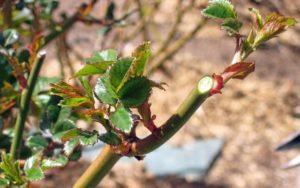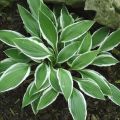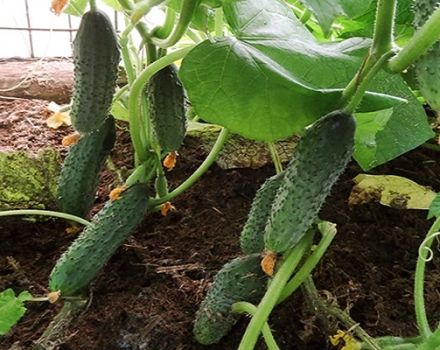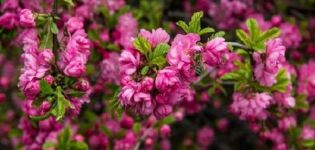Description and rules for growing roses of the Rhapsody in Blue variety
The Rhapsody in Blue rose variety interested flower growers with an unusual purple-violet color of the buds, which takes on a blue tint at dusk. Caring for a selection species consists in balanced watering and mandatory feeding during flowering. The advantages of the Rhapsody rose are frost resistance, long flowering and immunity to fungal diseases.
Content
- 1 The history of the creation of the Blue Rhapsody variety
- 2 Description and characteristics of the Rhapsody in Blue rose
- 3 Main advantages and disadvantages
- 4 Cultivation rules
- 5 Further care of the flower
- 6 Diseases, pests and methods of dealing with them
- 7 How to propagate?
- 8 The use of roses in landscape design
The history of the creation of the Blue Rhapsody variety
A blue or blue rose is a breeder's dream, like a black tulip. The British breeder Frank R. Cowslough came closest to the ideal. He crossed several varieties: Summer Vine, International Herald Tribune, Blue Moon, Montezuma, Violachia. The result is a flower with a deep purple-violet hue.
A new variety appeared in 1999 under the name Fantasy. But for presentation to the world community of flower growers in 2002 they chose a more poetic name - in honor of the play of the same name by J. Gershwin. Until now, the Blue Rhapsody rose is considered the closest to the blue palette.
Description and characteristics of the Rhapsody in Blue rose
The variety belongs to scrubs - winter-hardy park shrubs, as well as hybrid-polyanthus floribunda used in landscape design.
External features of the variety:
- thick bush;
- 80-165 centimeters high;
- 60 centimeters wide;
- erect shoots;
- sharp thorns;
- light green leaves with a glossy surface.
Bud structure:
- diameter - up to 6 centimeters;
- semi-double petals;
- one bud has 20 petals;
- buds are collected in 5-7 pieces;
- purple petals with a purple tint;
- the core is white with yellow stamens.
Flowers are evenly distributed on the bush. At the beginning of flowering, they are conical, and open in the form of a bowl. Rhapsody in Blue rose petals change color. When the buds are first opened, they are tinged with a gray-blue hue that changes to purple. In the shade and in cloudy weather, roses look purplish blue.
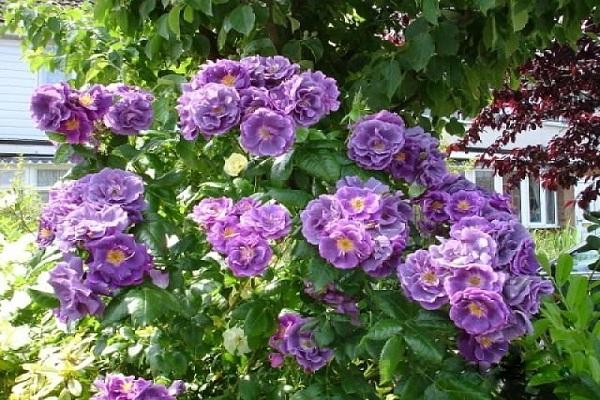
Main advantages and disadvantages
Benefits of Blue Rhapsody:
- withstands frost down to -20-23 degrees;
- not sensitive to powdery mildew;
- blooms long and profusely;
- smells spicy, with notes of clove;
- not demanding to care.
The variety blooms in two periods with an interval of up to a month. The disadvantage of flower growers is the rapid fall of buds and a change in the color of the petals, depending on the location of the bush.

Cultivation rules
In caring for Rhapsody Blue, it is important to choose moderate lighting and balance the watering regime.
Location selection
The geography of growing the variety Rhapsody in Blue extends from the Middle Belt to the northern regions.
An area with partial shade is suitable for planting roses - next to a hedge, trees, a gazebo. In the open area, roses fade. After burns from direct sunlight, the petals will not turn blue even at dusk. In a shaded and ventilated area, the bushes will be protected from overheating, and the flowers will retain their bluish-purple hue.
Do not plant roses in low, dark areas. Water gathers in the cold lowlands. From moisture and cold, a fungus develops on the roses. Wetlands with groundwater close to the surface are not suitable for a rose garden.
The minimum depth of the sources is 1 meter.
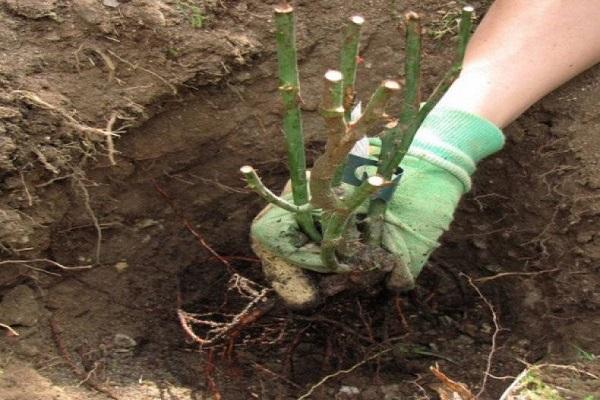
How to prepare the soil and flower for planting
Roses are planted from April to May. In autumn, bushes with developed roots are transplanted. The seedlings should take root before the cold weather, so the autumn planting is suitable for the southern regions.
In clayey areas, peat, sand or a mixture of humus and compost should be added to the soil. Sandy soil is poor in trace elements and nutrients, heats up in the sun and does not retain water. The sand should be mixed with clay, peat, compost or humus.
Before planting, the seedling is kept in a rooting solution for 30 minutes so that the roots develop faster.

Planting procedure step by step
How roses are planted:
- holes are dug at the site 60 centimeters deep, 40 centimeters in diameter;
- the interval between holes is 0.5 meters;
- put 10 centimeters of a layer of pebbles, rubble for drainage on the bottom;
- a layer of humus or compost of the same thickness is laid on top of the drainage;
- pour earth mixed with clay, bone meal and superphosphate, form a low slide;
- straighten the roots of the seedling, put it on the earthen layer, holding it with your hand;
- gradually fall asleep with soil.
Planting is completed with abundant watering. If the blue roses will form a hedge, young bushes should be planted at a 30-degree slope relative to the support. When planting near the wall of the house, you need to step back 0.5 meters from it so that rainwater from the roof does not flood the seedlings.
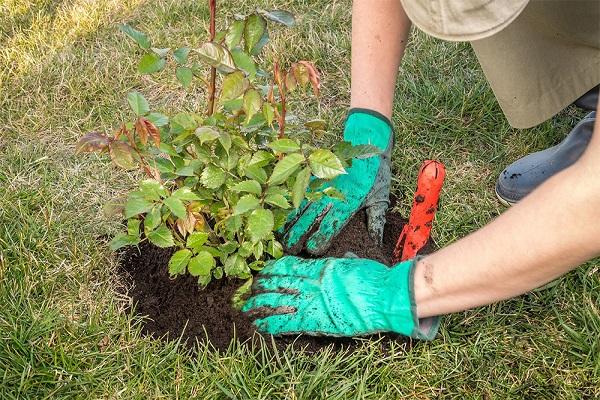
Further care of the flower
It is important for the health of the rose garden to keep watering in moderation. In order for the roses to bloom profusely every year, fertilizers must be applied during flowering, and the bushes must be cut before wintering.
Watering rules and humidity
Young bushes absorb a lot of moisture, especially in hot weather. But you should avoid stagnant water and water the rose garden in the evening when the sun is not baking. During the day, drops of water leave burns on the leaves.
The main rule for watering blue roses is to keep the soil moist and not let it dry out.
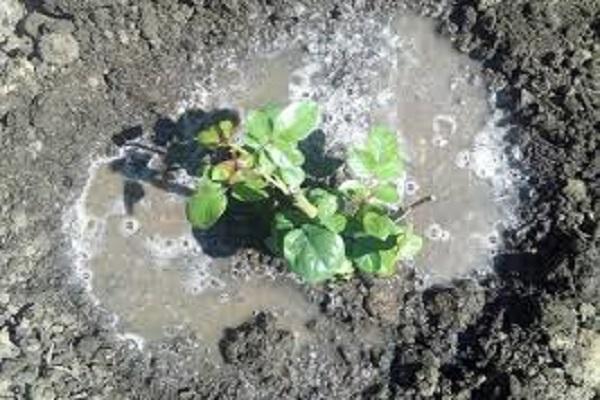
Top dressing and soil quality
Roses require dry, light, nutritious soil that is permeable to moisture and air. Water stagnates in fatty loams. Wetlands are also not suitable. In sandy-loamy soil with an admixture of humus, the Blue Rhapsody will easily receive oxygen, nutrition and moisture.
The normal soil ph for roses is 5.6-6.5. With the help of peat and humus, you can increase the acidity, and reduce it with ash and lime.
At the beginning of flowering, the bushes need fertilizing with nitrogen. From June to August, once every 2-3 weeks, roses are fed with organic fertilizer. When transplanting, humus is applied, when pruning - mineral fertilizers.
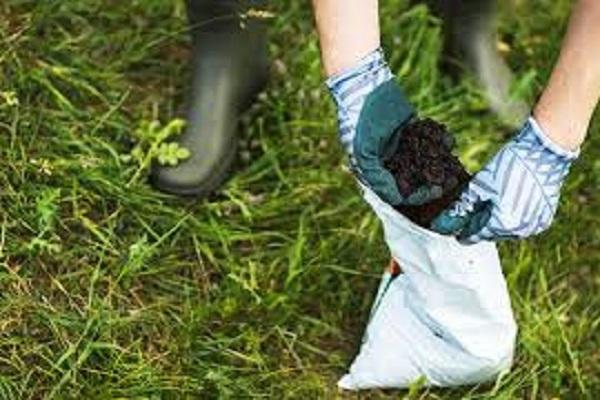
Pruning and replanting
In late autumn, before the bushes are sheltered for the winter, the faded buds that have not had time to form seed pods are cut off. Frozen and excess branches are cut off in spring. 3-4 minor ones are left on the main shoots. The main branches are shortened by a third. Pruning will increase flowering time and budding.
Features of wintering a flower
The Rhapsody in Blue variety does not require shelter at temperatures up to -7 degrees. When it gets cold, the bushes are cut off, spudded with garden soil, compost or humus. It is better not to use sawdust, sand and peat. This coating retains moisture, freezes, and the plants get sick.
For shelter, a frame is built, spruce branches are laid and wrapped with insulation. In early spring, holes are made in the coating for ventilation and prevention of early flowering. If the bushes are left closed, the buds will begin to turn green. Due to the lack of nutrients in the cold soil, they will dry out and the bush will not bloom in summer.

Diseases, pests and methods of dealing with them
Insects affecting rose bushes:
- rose aphid - the pest destroys young seedlings, their stems bend, and the leaves and unblown buds fall off. A soap solution, garlic tincture, ash are used against aphids. Also used are external and systemic insecticides - Karbofos and Aktara;
- spider mite, gall mite - live on the back of the leaves, leaving cobwebs and mealy bloom, the leaves turn yellow and fall off. Insects are destroyed only with insecticides;
- leafroller is a moth-like butterfly. Like a tick, it spoils the leaves by wrapping them and gluing them together with cobwebs. With a small lesion, twisted leaves are cut off, the bushes are treated with Aktara. Also, funds with permethrin are used to combat;
- leafhoppers are a very small insect, you can guess about its presence on the bushes by the light specks on the leaves. The plant loses its foliage and does not grow. Cicadas carry viruses. Against pests, spraying with soapy water, permethrin insecticide is carried out on the outside and back of the leaves.
The spheroteca fungus, the causative agent of a powdery white bloom on the leaves, develops at high humidity. Young seedlings growing in shady corners of the garden, where sunlight does not penetrate, are at risk of infection. Black spot appears with a lack of potassium. The leaves are covered with dark spots with a yellow border.
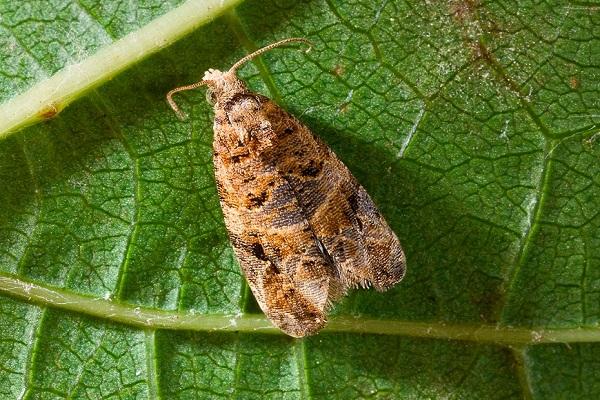
Removal of affected leaves, treatment with copper-soap solution, Bordeaux liquid will help against fungal diseases. With proper care and small deviations from the watering rate, the Rhapsody variety is resistant to powdery mildew and black spot.
How to propagate?
The Blue Rhapsody variety is propagated by cuttings. They are cut from young bushes after the first flowering period. An oblique cut is made just above the kidney. The length of the cuttings should be 10 centimeters. Make an even cut at the top.
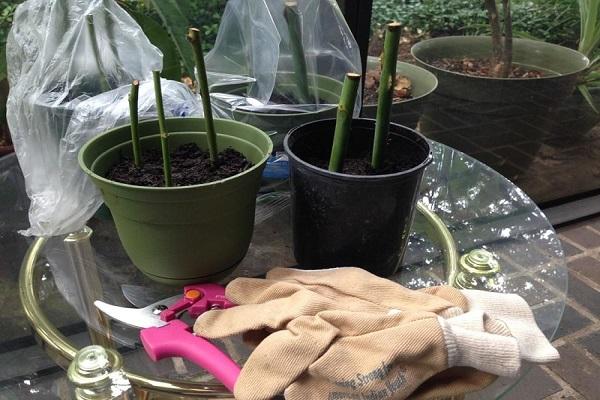
The cuttings are kept in a solution of a preparation that accelerates the formation of roots. After the roots appear, the twigs are planted in a seedling box or in pots.
The use of roses in landscape design
Plants are planted next to blue roses, which are shorter in growth so that they do not obscure the buds. When forming a hedge, roses should be planted three bushes at intervals, filling it with other plants. The contrasting combination will be yellow flowers.
Roses of the Rhapsody in Blue variety are used in the preparation of summer and autumn compositions, single flower beds and hedges.

